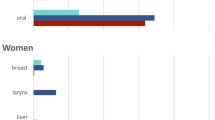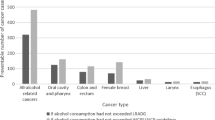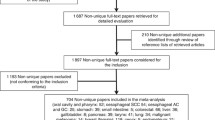Abstract
Purpose of Review
To provide an overview of the risk relationships between alcohol use and cancer and of the alcohol-attributable cancer burden; to highlight areas of controversy in the alcohol–cancer relationship; to examine the reasons why these risk relationships have not received greater public attention.
Recent Findings
In 2016, alcohol caused an estimated 376,200 cancer deaths, 10.0 million cancer years of life lost (YLLs), 236,600 cancer years lived with disability (YLDs), and 10.3 million cancer disability-adjusted years of life (DALYs), representing 4.2%, 4.2%, 4.6%, and 4.2% of all deaths, YLLs, YLDs, and DALYs lost due to cancer, respectively, proportionally highest in high- and upper–middle–income countries.
Summary
Alcohol use is a major contributor to cancer and is linked to the most prevalent types of cancer. No threshold for the effects of alcohol on cancer has yet been identified, and thus, abstinence is best for cancer prevention. Greater public awareness of the relationship between alcohol use and cancer is advisable.


Similar content being viewed by others
References
Papers of particular interest, published recently, have been highlighted as: • Of importance •• Of major importance
International Agency for Research on Cancer. Alcohol drinking. Lyon, France: IARC; 1988.
IARC Working Group on the Evaluation of Carcinogenic Risks to Humans. Alcohol consumption and ethyl carbamate. IARC Monogr Eval Carcinog Risks Hum. 2010;96:1-1383.
IARC Working Group on the Evaluation of Carcinogenic Risks to Humans. Personal habits and indoor combustions. Volume 100 E. A review of human carcinogens. IARC Monogr Eval Carcinog Risks Hum. 2012;100(Pt E):1-538.
World Cancer Research Fund/American Institute for Cancer Research. Diet, nutrition, physical activity and cancer: a global perspective. Continuous Update Project expert report 2018. London, United Kingdom. 2018.
WHO European Region. Alcohol consumption, harm and policy responses in 30 European countries in 2016. Copenhagen, Denmark: WHO European Region. Copenhagen, Denmark: WHO European Region; 2019.
Bagnardi V, Rota M, Botteri E, Tramacere I, Islami F, Fedirko V, et al. Light alcohol drinking and cancer: a meta-analysis. Ann Oncol. 2013;24(2):301–8.
Choi YJ, Myung SK, Lee JH. Light alcohol drinking and risk of cancer: a meta-analysis of cohort studies. Cancer Res Treat. 2018;50(2):474–87.
Cao Y, Willett WC, Rimm EB, Stampfer MJ, Giovannucci EL. Light to moderate intake of alcohol, drinking patterns, and risk of cancer: results from two prospective US cohort studies. BMJ. 2015;351:h4238.
Rehm J. Light or moderate drinking is linked to alcohol related cancers, including breast cancer. BMJ. 2015;351:h4400.
Lamy L. Étude clinique et statistique de 134 cas de cancer de l’oesophage et du cardia. Archives des maladies de L’Appareil Digestif. 1910;4:451–75.
Scheideler JK, Klein WMP. Awareness of the link between alcohol consumption and cancer across the world: a review. Cancer epidemiology, biomarkers & prevention: a publication of the American Association for Cancer Research, cosponsored by the American Society of Preventive. Oncology. 2018;27(4):429–37.
Less Cancer. Cancer risk: is perception aligned with reality?—part two. 2017. https://www.lesscancer.org/cancer-risk-is-perception-aligned-with-reality-part-two/. Accessed 01/02/2019.
Bagnardi V, Rota M, Botteri E, Tramacere I, Islami F, Fedirko V, et al. Alcohol consumption and site-specific cancer risk: a comprehensive dose-response meta-analysis. Br J Cancer. 2015;112(3):580–93.
• Rehm J, Gmel GE Sr, Gmel G, Hasan OS, Imtiaz S, Popova S, et al. The relationship between different dimensions of alcohol use and the burden of disease—an update. Addiction. 2017;112(6):968–1001 Overview on risk relations between alcohol use and different disease outcomes.
Rothman KJ, Greenland S, Lash TL. Modern epidemiology. Third ed. Philadelphia, PA: Lippincott Williams & Wilkins; 2008.
International Agency for Research on Cancer. IARC Monographs on the evaluation of carcinogenic risks to humans. Preamble to the IARC Monogr Eval Carcinog Risks Hum. 2006.
• Rehm J, Shield KD, Weiderpass E. Alcohol consumption: a leading risk factor for cancer. In: IARC, editor. World Cancer Report. Lyon, France: IARC; 2019. (In press). Most recent overview on alcohol use and cancer.
Bergmann MM, Rehm J, Klipstein-Grobusch K, Boeing H, Schütze M, Drogan D, et al. The association of pattern of lifetime alcohol use and cause of death in the European Prospective Investigation into Cancer and Nutrition (EPIC) study. Int J Epidemiol. 2013;42(6):1772–90.
Liu Y, Nguyen N, Colditz GA. Links between alcohol consumption and breast cancer: a look at the evidence. Women’s Health. 2015;11(1):65–77.
Liu Y, Colditz GA, Rosner B, Berkey CS, Collins LC, Schnitt SJ, et al. Alcohol intake between menarche and first pregnancy: a prospective study of breast cancer risk. J Natl Cancer Inst. 2013;105(20):1571–8.
Ahmad-Kiadaliri A, Jarl J, Gavriilidis G, Gerdtham UG. Alcohol drinking cessation and the risk of laryngeal and pharyngeal cancers: a systematic review and meta-analysis. PLoS One. 2013;8(3):e58158.
Jarl J, Heckley G, Brummer J, Gerdtham UG. Time characteristics of the effect of alcohol cessation on the risk of stomach cancer—a meta-analysis. BMC Public Health. 2013;13:600.
Rehm J, Patra J, Popova S. Alcohol drinking cessation and its effect on esophageal and head and neck cancers: a pooled analysis. Int J Cancer. 2007;121(5):1132–7.
Li H, Borinskaya S, Yoshimura K, Kal’ina N, Marusin A, Stepanov VA, et al. Refined geographic distribution of the oriental ALDH2*504Lys (nee 487Lys) variant. Ann Hum Genet. 2009;73(Pt 3:335–45.
Hurley TD, Edenberg HJ. Genes encoding enzymes involved in ethanol metabolism. Alcohol Res. 2012;34(3):339–44.
Roerecke M, Shield KD, Higuchi S, Yoshimura A, Larsen E, Rehm MX, et al. Estimates of alcohol-related oesophageal cancer burden in Japan: systematic review and meta-analyses. Bull World Health Org. 2015;93:329–38.
Pierce BL, Kraft P, Zhang C. Mendelian randomization studies of cancer risk: a literature review. Curr Epidemiol Rep. 2018;5(2):184–96.
•• Bray F, Ferlay J, Soerjomataram I, Siegel RL, Torre LA, Jemal A. Global cancer statistics 2018: GLOBOCAN estimates of incidence and mortality worldwide for 36 cancers in 185 countries. CA Cancer J Clin. 2018;68(6):394–424 Overview on latest cancer epidemiology.
Ferlay J, Colombet M, Soerjomataram I, Mathers C, Parkin DM, Pineros M, et al. Estimating the global cancer incidence and mortality in 2018: GLOBOCAN sources and methods. Int J Cancer. Int J Cancer. 2019;144(8):1941-1953.
Liu Z, Jiang Y, Yuan H, Fang Q, Cai N, Suo C, et al. The trends in incidence of primary liver cancer caused by specific etiologies: results from the Global Burden of Disease Study 2016 and implications for liver cancer prevention. J Hepatol. 2018.
Bray F, Ferlay J, Laversanne M, Brewster DH, Gombe Mbalawa C, Kohler B, et al. Cancer incidence in five continents: inclusion criteria, highlights from volume X and the global status of cancer registration. Int J Cancer. 2015;137(9):2060–71.
Arnold M, Laversanne M, Brown LM, Devesa SS, Bray F. Predicting the future burden of esophageal Cancer by histological subtype: international trends in incidence up to 2030. Am J Gastroenterol. 2017;112(8):1247–55.
• World Health Organization. Global status report on alcohol and health 2018. Geneva: World Health Organization; 2018. https://www.who.int/substance_abuse/publications/global_alcohol_report/en/. Accessed 01/06/2019. Most recent overview by WHO on alcohol use, attributable disease, and policy.
Murray CJ, Lopez AD. On the comparable quantification of health risks: lessons from the Global Burden of Disease Study. Epidemiology. 1999;10(5):594–605.
Rehm J, Monteiro M, Room R, Gmel G, Jernigan D, Frick U, et al. Steps towards constructing a global comparative risk analysis for alcohol consumption: determining indicators and empirical weights for patterns of drinking, deciding about theoretical minimum, and dealing with different consequences. Eur Addict Res. 2001;7(3):138–47.
Rehm J, Room R, Monteiro M, Gmel G, Graham K, Rehn N, et al. Alcohol use. In: Ezzati M, ADL AR, Murray CJL, editors. Comparative quantification of health risks. Global and regional burden of disease attributable to selected major risk factors. Geneva: World Health Organization; 2004. p. 959–1108.
• Allemani C, Matsuda T, Di Carlo V, Harewood R, Matz M, Niksic M, et al. Global surveillance of trends in cancer survival 2000-14 (CONCORD-3): analysis of individual records for 37 513 025 patients diagnosed with one of 18 cancers from 322 population-based registries in 71 countries. Lancet. 2018;391(10125):1023–75 Most recent overview on treands in cancer survival.
Dal Maso L, Torelli N, Biancotto E, Di Maso M, Gini A, Franchin G, et al. Combined effect of tobacco smoking and alcohol drinking in the risk of head and neck cancers: a re-analysis of case-control studies using bi-dimensional spline models. Eur J Epidemiol. 2016;31(4):385–93.
The World Bank. The World Bank: open data. 2018. http://data.worldbank.org/.
• Manthey J, Shield K, Rylett M, Hasan OSM, Probst C, J. R. Alcohol exposure between 1990 and 2017 and forecasts until 2030: a global modelling study. Lancet. 2019; (in press). Overview on global trends in alcohol use including predictions.
Pflaum T, Hausler T, Baumung C, Ackermann S, Kuballa T, Rehm J, et al. Carcinogenic compounds in alcoholic beverages: an update. Arch Toxicol. 2016;90(10):2349–67.
• Petticrew M, Maani Hessari N, Knai C, Weiderpass E. How alcohol industry organisations mislead the public about alcohol and cancer. Drug Alcohol Rev. 2018;37(3):293–303 Discussion of the role of alcohol industry to impact on public perception.
Petticrew M, Maani Hessari N, Knai C, Weiderpass E. The strategies of alcohol industry SAPROs: inaccurate information, misleading language and the use of confounders to downplay and misrepresent the risk of cancer. Drug Alcohol Rev. 2018;37(3):313–5.
Jin M, Cai S, Guo J, Zhu Y, Li MD, Yu Y, et al. Alcohol drinking and all cancer mortality: a meta-analysis. Ann Oncol. 2013;24(3):807–16.
Fekjaer HO. Alcohol-a universal preventive agent? A critical analysis. Addiction. 2013;108(12):2051–7.
Rehm J, Irving H, Ye Y, Kerr WC, Bond J, Greenfield TK. Are lifetime abstainers the best control group in alcohol epidemiology? On the stability and validity of reported lifetime abstention. Am J Epidemiol. 2008;168(8):866–71.
Naimi TS, Stockwell T, Zhao J, Xuan Z, Dangardt F, Saitz R, et al. Selection biases in observational studies affect associations between ‘moderate’ alcohol consumption and mortality. Addiction. 2017;112(2):207–14.
Rehm J. The role of the comparison group in epidemiology and general limitations. Addiction. 2013;108(12):2058–9.
Rehm J. On the limitations of observational studies. Addict Res Theory. 2007;15(1):20–2.
Shield KD, Soerjomataram I, Rehm J. Alcohol use and breast cancer: a critical review. Alcohol Clin Exp Res. 2016;40(6):1166–81.
Hamajima N, Hirose K, Tajima K, Rohan T, Calle EE, Heath CW Jr, et al. Alcohol, tobacco and breast cancer—collaborative reanalysis of individual data from 53 epidemiological studies, including 58,515 women with breast cancer and 95,067 women without the disease. Br J Cancer. 2002;87(11):1234–45.
Allen NE, Beral V, Casabonne D, Kan SW, Reeves GK, Brown A, et al. Moderate alcohol intake and cancer incidence in women. J Natl Cancer Inst. 2009;101(5):296–305.
Kalinowski A, Humphreys K. Governmental standard drink definitions and low-risk alcohol consumption guidelines in 37 countries. Addiction. 2016;111(7):1293–8.
Steichen O, Demay J, Grateau G. Light drinking has positive public health consequences. Ann Oncol. 2013;24(5):1420–1.
Bagnardi V, Botteri E, Rota M, Pelucchi C, Corrao G, Rehm J, et al. Re: light drinking has positive public health consequences. Ann Oncol. 2013;24(5):1421–2.
Myung SK. Erroneous conclusions about the association between light alcohol drinking and the risk of cancer: comments on Bagnardi et al.’s meta-analysis. Ann Oncol. 2016;27(11):2138.
Bagnardi V, Botteri E, La Vecchia C. Reply to the letter to the editor ‘Erroneous conclusions about the association between light alcohol drinking and the risk of cancer: comments on Bagnardi et al.’s meta-analysis, by S.-K. Myung’. Ann Oncol. 2016;27(11):2138–9.
Franco EL, Correa P, Santella RM, Wu X, Goodman SN, Petersen GM. Role and limitations of epidemiology in establishing a causal association. Semin Cancer Biol. 2004;14(6):413–26.
Plummer M, de Martel C, Vignat J, Ferlay J, Bray F, Franceschi S. Global burden of cancers attributable to infections in 2012: a synthetic analysis. Lancet Glob Health. 2016;4(9):e609–16.
Gaddy JA, Radin JN, Loh JT, Zhang F, Washington MK, Peek RM Jr, et al. High dietary salt intake exacerbates Helicobacter pylori-induced gastric carcinogenesis. Infect Immun. 2013;81(6):2258–67.
International Tobacco Control Policy Evaluation Project (ITC). Cardiovascular harms from tobacco use and secondhand smoke: global gaps in awareness and implications for action. 2012 (April). https://www.itcproject.org/files/ITC_WHF_Bro-Apr18-v2-web.pdf. Access 14 March 2019
Soerjomataram I, Shield K, Marant-Micallef C, Vignat J, Hill C, Rogel A, et al. Cancers related to lifestyle and environmental factors in France in 2015. Eur J Cancer. 2018;105:103–13.
Room R. Alcohol, the individual and society: what history teaches us. Addiction. 1997;92(Suppl 1):S7–11.
Room R, Jernigan D, Carlini-Marlatt B, Gureje O, Mäkelä K, Marshall M, et al. Alcohol in developing societies: a public health approach. Helsinki: Finnish foundation for alcohol studies; 2002.
GBD Risk Factors Collaborators, Dicker D, Nguyen G, Abate D, Abate KH, Abay SM et al. Global, regional, and national age-sex-specific mortality and life expectancy, 1950–2017: a systematic analysis for the Global Burden of Disease Study 2017. Lancet 2018;392(10159):1684–1735.
Zhao J, Stockwell T, Roemer A, Naimi T, Chikritzhs T. Alcohol consumption and mortality from coronary heart disease: an updated meta-analysis of cohort studies. J Stud Alcohol Drugs. 2017;78(3):375–86.
Roerecke M, Rehm J. Alcohol consumption, drinking patterns, and ischemic heart disease: a narrative review of meta-analyses and a systematic review and meta-analysis of the impact of heavy drinking occasions on risk for moderate drinkers. BMC Med. 2014;12(1):182.
EUCAM The European Centre for Monitoring Alcohol Marketing. The seven key messages of the alcohol industry: information for everyone who wants to be aware of the real intentions of the alcohol industry. 2011. http://eucam.info/wp-content/uploads/2014/04/seven_key_messages_of_the_alcohol_industry.pdf. Accessed 02/01/2019.
Hammond D. Health warning messages on tobacco products: a review. Tob Control. 2011;20(5):327–37.
European Commission. Report from the Commission to the European Parliament and the Council regarding the mandatory labelling of the list of ingredients and the nutrition declaration of alcoholic beverages. Europa, Brussels. 2017. https://zdoc.site/risk-assessment-methodologies-and-approaches-for-mutagenic-a.html. Accessed 01/06/2019.
World Health Organization. Global strategy to reduce the harmful use of alcohol. 2010. http://www.who.int/substance_abuse/activities/gsrhua/en/. Access 14 March 2019
Llopis EJ, Kokole D, Neufeld M, Hasan OSM, Rehm J. Evidence synthesis report on alcohol labelling. Barcelona: HEN REVIEW prepared for WHO Health Evidence Network; 2019.
Canadian Broadcasting Corporation (CBC). Liquor industry calls halt to cancer warning labels on Yukon booze. CBC, Toronto, Ontario. 2017. https://www.cbc.ca/news/canada/north/yukon-liquor-label-backlash-1.4466330. Accessed: 01/06/2019.
O’Brien P, Gleeson D, Room R, Wilkinson C. Commentary on ‘Communicating messages about drinking’: using the ‘big legal guns’ to block alcohol health warning labels. Alcohol Alcohol. 2018;53(3):333–6.
Bates S, Holmes J, Gavens L, de Matos EG, Li J, Ward B, et al. Awareness of alcohol as a risk factor for cancer is associated with public support for alcohol policies. BMC Public Health. 2018;18(1):688.
Author information
Authors and Affiliations
Corresponding author
Ethics declarations
Conflict of Interest
Jürgen Rehm, Isabelle Soerjomataram, Carina Ferreira-Borges, and Kevin D. Shield declare that they have no conflict of interest.
Human and Animal Rights and Informed Consent
This article does not contain any studies with human or animal subjects performed by any of the authors.
Additional information
Publisher’s Note
Springer Nature remains neutral with regard to jurisdictional claims in published maps and institutional affiliations.
This article is part of the Topical Collection on Cancer
Rights and permissions
About this article
Cite this article
Rehm, J., Soerjomataram, I., Ferreira-Borges, C. et al. Does Alcohol Use Affect Cancer Risk?. Curr Nutr Rep 8, 222–229 (2019). https://doi.org/10.1007/s13668-019-0267-0
Published:
Issue Date:
DOI: https://doi.org/10.1007/s13668-019-0267-0




